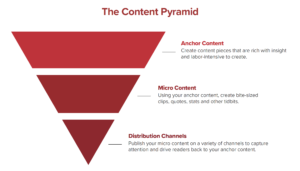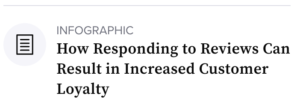This is post #3 in 10-part series on the New B2B Marketing Paradigm.
In the previous post, we discussed how, to truly earn attention from prospects, you must provide value in every interaction. In this post, we’re going to talk about how to do that: by creating and distributing high-quality content.
So, how do you gain the attention of the audience you’re seeking and get them wanting more from you? It all comes down to three key steps.
The Content Strategy That Actually Creates Value
- First, create your anchor content. This is the top of your content pyramid, where your team will develop long-form white papers, videos, case studies, testimonials, webinars and more. Because these pieces will be rich with insight and labor-intensive to create, you’ll be making the most of each one. (Lots can be said about the best ways to research, write, and produce these pieces, but that will have to be the focus of another post.)
- Second, develop your micro content. For every piece of anchor content you create, you will also want to peel off bite-sized clips, quotes, stats and other tidbits that tease the core content.
- Third, push this content to your distribution channels. Finally, you’ll publish your micro content on a variety of channels—such as social media, trade media, paid advertising, and email—to capture attention and drive readers back to your anchor content.

Thanks to the Gary Vee Content Model for the bones of this strategy—still as effective today as it was a few years ago.
But Won’t Repeating the Same Content Get Boring and Repetitive? Not If You’re Doing It Right.
Here’s a tip: As you create your anchor content, also create a companion document where you can deposit the micro content you lift from your core piece. This could be a chart that highlights the point of the article, a quote from a client, or a short audio clip of a podcast that makes a salient point. Then, when it’s time to populate your ads, social media posts, and other distribution channels, you’ll have valuable, purposeful headlines and images at the ready.
It’s important to make your micro content compelling. If you’ve done your anchor content right, everything you need is already there. And yet, so often we come across boring ads that simply state the title of the content they’re meant to tease. Consider the following example. It’s a screen shot we snagged from the partner ad area of a publishing website (names removed to protect the innocent):

This ad just isn’t compelling enough to grab a busy reader’s attention. We clicked through, downloaded the linked anchor content, and found that it was rich with insights and meaty facts—any one of which would have made stronger micro content than what was selected. Imagine the ad had read like this:

We’d bet some gated content it would have led to increased conversions. In fact, we find that when we put this practice in place, we see a 150% increase in conversion rates on average.
Strong micro content can lead to a 150% increase in conversions.
One CEO told us: “I don’t know what you are doing for us, but you are killing it. I see ads in all these trade publications and I’m thinking, ‘I need to read that.’ Then I click through and find out it is my own content.” That made us smile.
In the next post, we’ll discuss how to structure your marketing team in a way that facilitates creating the high-quality content we’ve just been talking about.
In the meantime, let us know how your own shift from quantity to quality demand-gen is going—and reach out if you find you could use some help.
